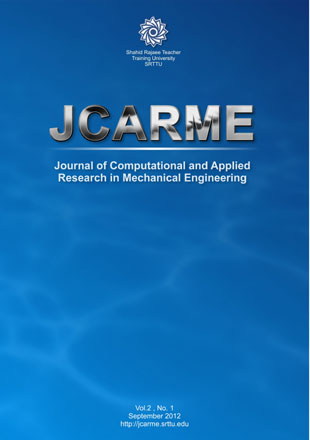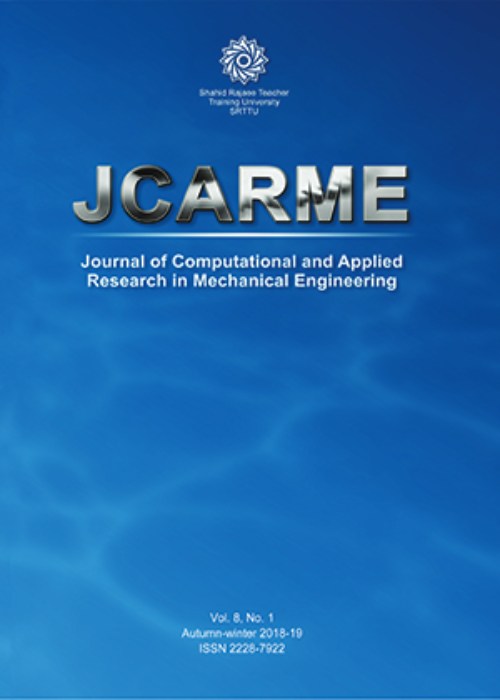فهرست مطالب

Journal of Computational and Applied Research in Mechanical Engineering
Volume:2 Issue: 1, Autumn2012
- تاریخ انتشار: 1391/07/20
- تعداد عناوین: 7
-
-
Page 1Metal matrix composites (MMCs) have been widely used in industries, especially aerospace industries, due to their excellent engineering properties. However, it is difficult to machine them because of the hardness and abrasive nature of reinforcement elements like silicon carbide particles (SiCp). In the present study, an attempt has been made to investigate the influence of spindle speed (N), feed rate (f), depth of cut (d) and various %wt. of silicon carbide (S) manufactured through stir cast route on tool flank wear and surface roughness during end milling of LM25 Al-SiCp metal matrix composites. Statistical models based on second order polynomial equations were developed for the different responses. Analysis of variance (ANOVA) was carried out to identify the significant factors affecting the tool flank wear and surface roughness. The contour plots were generated to study the effect of process parameters as well as their interactions. The process parameters are optimized using desirability-based approach response surface methodology.Keywords: Metal matrix composites (MMC), Response surface methodology (RSM), Flank wear (VBmax), Surface oughness (Ra), Contour plots, Optimization
-
Page 13A xial vibration effect of shell particles on dynamic stability of a cantilevered cylindrical shell under an axial follower force was addressed. In spite of free-ended shells, the reduced axial force under this effect cannot be derived analytically. Instead, an approximate method was proposed based on the fact that the static (and harmonic) axial deformation under an axial load in a free-ended beam are (almost) zero in a particular point near the middle of the beam, which was adopted as the equivalent fixed end of a cantilever. The work done by the nonconservative follower force was derived for a cantilevered beam and was extended to the case of a cantilevered cylindrical shell. The flutter load for a long free-ended shell was calculated using the equivalent cantilevered half-shell and compared with the previous results. Then, flutter load was calculated with and without the axial vibration effect for cantilevered shells with different lengths and thicknesses and the effect of each parameter was assessed on the flutter load and the critical circumferential mode number in each case.Keywords: Axial follower force, Flutter, Cantilevered cylindrical shell, Circumferential mode number
-
Page 23In this paper, a positive definite semi-discrete mixed finite element method was presented for two-dimensional parabolic equations. In the new positive definite systems, the gradient equation and flux equations were separated from their scalar unknown equations. Also, the existence and uniqueness of the semi-discrete mixed finite element solutions were proven. Error estimates were also obtained for the semi-discrete schemes. Finally, a numerical example was presented to show theoretical results.Keywords: Parabolic equations, Positive definite systems, Semi, discrete mixed finite element methods, Error estimates
-
Page 29The current study conducted a finite element (FE) and experimental investigation on tubular channel angular pressing as a noble severe plastic deformation technique for producing ultrafine grained and nanostructure tubular components. To examine the effects of the TCAP process on the strain distribution and deformation behavior, FE simulations were employed. The FE results demonstrated that equivalent plastic strain of 2.1-2.9 was developed after applying one pass TCAP. Analytical investigations were carried out to calculate the accumulated strain during the process. Tube thinning in the early stages of the process was observed as a result of tensile circumferential strains but this could be compensated for by the back pressure effect resulting from the next shear zones and also compressive circumferential strain resulting from decreasing the tube diameter. Microstructural observations showed significant grain refinement after one pass TCAP on AZ91 magnesium alloy at 300 ºC. Microhardness measurements demonstrated increasing hardness to 78 HV from the initial value of 51 HV.Keywords: Sever plastic deformation, Tubular channel angular pressing, Finite element, Experiments
-
Page 35In the present paper, the flow and heat transfer of two types of nanofluids, namely, silver-water and silicon dioxide-water, were theoretically analyzed over an isothermal continues stretching sheet. To this purpose, the governing partial differential equations were converted to a set of nonlinear differential equations using similarity transforms and were then analytically solved. It was found that the magnitude of velocity profiles in the case of SiO2-water nanofluid was higher than that of Ag-water nanofluid. The results showed that the increase of nanoparticle volume fraction increased the non-dimensional temperature and thickness of thermal boundary layer. In both cases of silver and silicon dioxide, increase of nanoparticle volume fraction increased the reduced Nusselt number and shear stress. It was also demonstrated that the increase of the reduced Nusselt number was higher for silicon dioxide nanoparticles than silver nanoparticles. However, the thermal conductivity of silver was much higher than that of silicon dioxide.Keywords: Nanofluids, Stretching sheet, Thermal enhancement, Wall mass transfer, Analytical solution
-
Page 49In this paper, lift and drag coefficients were numerically investigated using NUMECA software in a set of 4-digit NACA airfoils. Two metamodels based on the evolved group method of data handling (GMDH) type neural networks were then obtained for modeling both lift coefficient (CL) and drag coefficient (CD) with respect to the geometrical design parameters. After using such obtained polynomial neural networks, modified non-dominated sorting genetic algorithm (NSGAII) was used for Pareto based optimization of 4-digit NACA airfoils considering two conflicting objectives such as (CL) and (CD). Further evaluations of the design points in the obtained Pareto fronts using the NUMECA software showed the effectiveness of such an approach. Moreover, it was shown that some interesting and important relationships as the useful optimal design principles involved in the performance of the airfoils can be discovered by the Pareto-based multi-objective optimization of the obtained polynomial meta-models. Such important optimal principles would not have been obtained without using the approach presented in this paper.Keywords: Multi, objective Optimization, GMDH, Genetic Algorithm, 4, Digit NACA Airfoils, NUMECA
-
Page 61In the presented work, sulfur concrete and rubber were used for producing functionally graded materials (FGM). The physical and mechanical properties of sulfur concrete and rubber were changed continuously across the thickness. On one side, there was just rubber and, on the other, there was pure sulfur; the properties of each substance were moved to reach another. This kind of material was constructed by applying mechanical pressure on all layers together and heating in a casting die. Thus, it is essential to consider the quantity of sulfur and rubber at each layer and the rule obeyed by physical and mechanical properties. In the drop test, it was found that the elastic impact coefficient changed from sulfur concrete around 50% to rubber around near zero. It seems that, by changing some parameters like combination percentage or layer's thickness, it is possible to optimize the FGM.Keywords: FGM, SULFUR, RUBBER, COR


